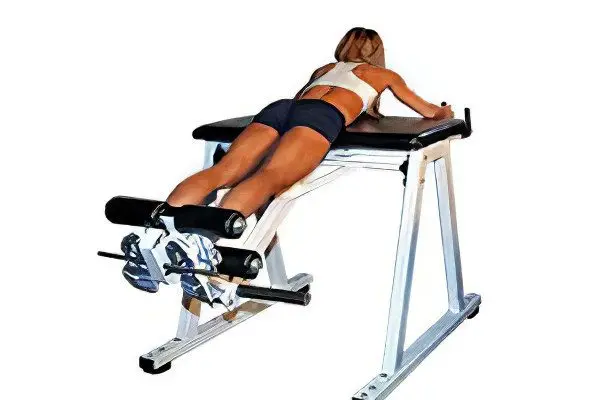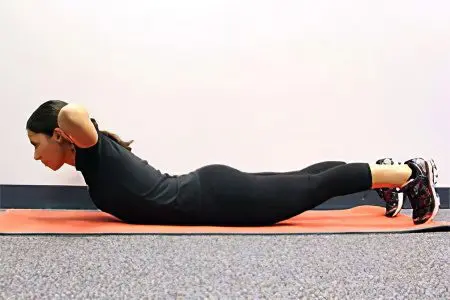Contents
The muscles of the back and spine need to be strengthened. They are a support for the entire body, allow you to support the internal organs, prevent the curvature of the spinal column. To keep the muscles in good shape, you need to perform special exercises. The most effective of these is reverse hyperextension.
Benefits of reverse hyperextension

Compared to classic hyperextension, reverse hyperextension is a safer option. Performing this exercise eliminates the risk of injury to the spinal column.
The complex can be practiced by people suffering from back pain, from various diseases of the spine, including patients with hernia and osteochondrosis.
During the exercise, not only the back muscles are worked out, but also the muscle structures of the buttocks and lower extremities. If you perform reverse hyperextension with loads, you will be able to get a faster result.
Before starting to exercise, you should consult with a specialist. This is especially true for those people who already have diseases of the musculoskeletal system.
The exercise is great for both beginners and experienced athletes. It can be practiced by girls who want to pump up their buttocks.
What muscles work during reverse hyperextension?

Performing reverse hyperextension, a person involves the following muscle groups in the work:
Muscles of the buttocks.
Back extensors.
Biceps femoris.
Square muscles of the lower back.
Semitendinosus muscles.
Abdominal muscles.
Muscles of the hands.
How to do the exercise?

Before starting the exercise, you should take care of the presence of a flat, even surface on which you can lie on your stomach and hang your legs. This surface should be at the height of the length of the person’s legs.
Step by step technique:
It is necessary to lie on a flat surface with your stomach down. In this case, the body should be fixed with the help of hands.
The lower limbs are lifted up due to the muscles of the thigh and buttocks.
On inspiration, they are raised as high as possible. The muscles of the thighs and buttocks should be as tense as possible.
In this position, you should linger for a minute, and then lower your legs down. At the same time exhale.
The number of repetitions of the exercise is 12-15. Then a short break follows and another approach is performed. The number of approaches can be equal to 2-3.
Other options for performing reverse hyperextension
Modern gyms often do not have specialized equipment for this exercise. Therefore, it is necessary to look for an alternative to it.
Substitutions can be:
Fitball.
Bench.
Any other flat, elevated surface.
Workouts at home

You can do the exercise at home. The only difficulty is finding a suitable projectile on which to lean the hull. Therefore, you can train on the floor.
A person lies on the floor, puts his hands behind his back, crossing them, or stretches his arms along the body. Then you need to try to raise your legs to the maximum height so that your hips come off the floor. To facilitate the exercise, you can stretch your arms in front of you. Then they need to be lifted along with the lower limbs.
At home, you can also use a fitball to perform reverse hyperextension. To do this, lie on the surface of the ball with your stomach, rest your hands on the floor and lift your legs.
For whom is reverse hyperextension contraindicated?
The exercise can be performed by people with various diseases of the spinal column, for example, with a hernia, osteomyelitis, osteochondrosis.
However, there are a number of limitations to its implementation:
Diseases of the spine in the acute stage.
Previous injuries to the lumbosacral spine.
How to avoid injury during exercise?
Reverse hyperextension is recognized as a safe exercise, but it should be performed carefully, observing a number of rules. So, the surface on which a person lies down must be stable.
It is important to monitor the position of the back. It must be perfectly flat. Rounding your back can lead to bad posture.
The legs are lifted up on the exhale, and lowered down on the inhale. Breathing should be uniform, without delays and interruptions.
Common mistakes
The most common mistakes that trainees make are:
Sharp leg lifts, accompanied by jerks. This technique threatens to damage the muscles of the back.
At the initial stage of the exercise, you should not use weights.
The legs must remain straight at all times. They cannot be bent.
Important recommendations

In order for the exercise to bring maximum benefit, you must adhere to the following recommendations:
During the exercise, you should keep the body in a stationary state.
It is important to monitor the work of the muscles.
The muscles of the neck and body should not be in tension. The head should be kept straight, without turning it back.
To increase the load on the biceps of the thigh, you need to turn the socks inward.
At the peak point, you should strain the muscles of the buttocks.
The range of motion must be strictly observed.
Reverse hyperextension should be performed before and after training.
If a weighting agent is used, then it is put on the legs. You can also just clamp the dumbbells with your lower limbs.
To further complicate the technique of performing the exercise, in the ascent, you can spread your legs in different directions. However, this option is suitable for trained athletes. Moreover, the load on the joints increases, and the exercise becomes potentially dangerous.
As a warm-up before performing reverse hyperextension, you can perform walking in place, or squats.
Reverse hyperextension is a great way to pump the gluteal muscles, thigh muscles and back. Exercise allows you to get a beautiful trained body and improve your health.
[Video] Reverse hyperextension: execution technique:









